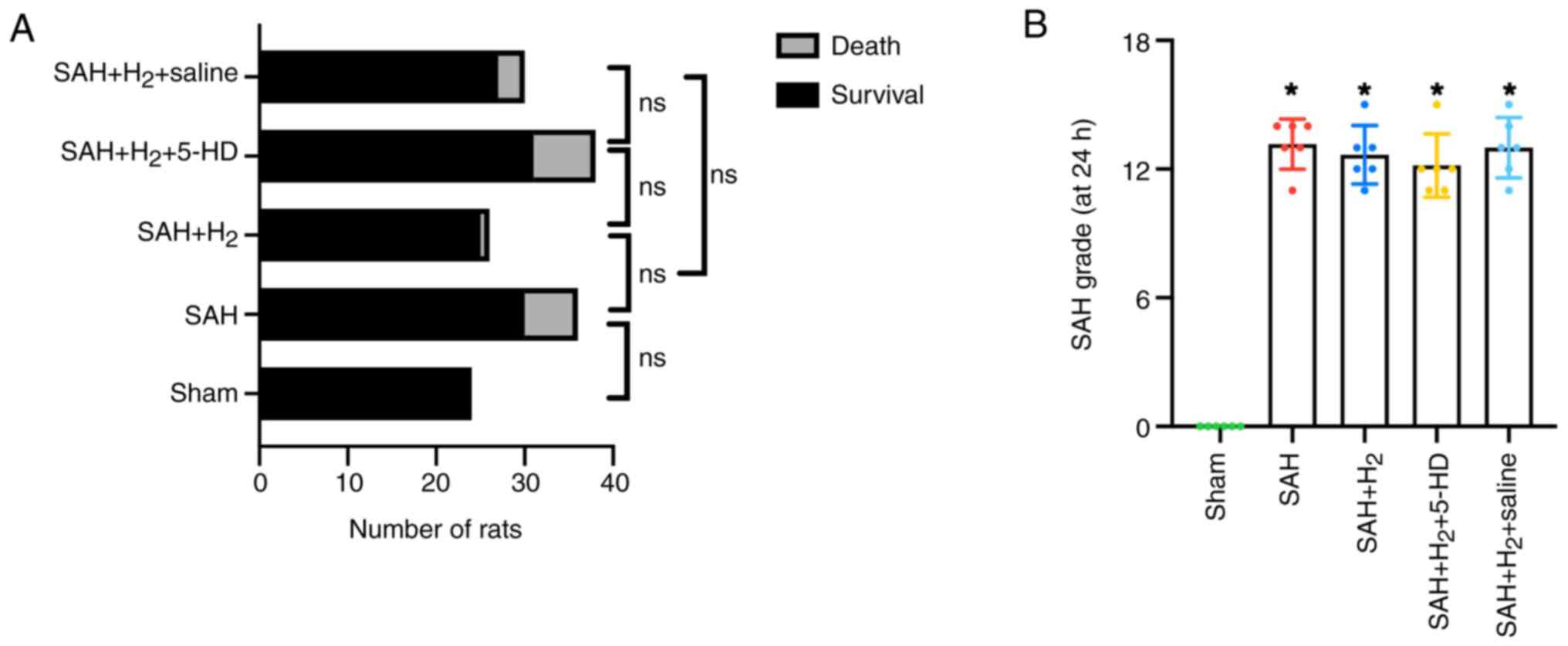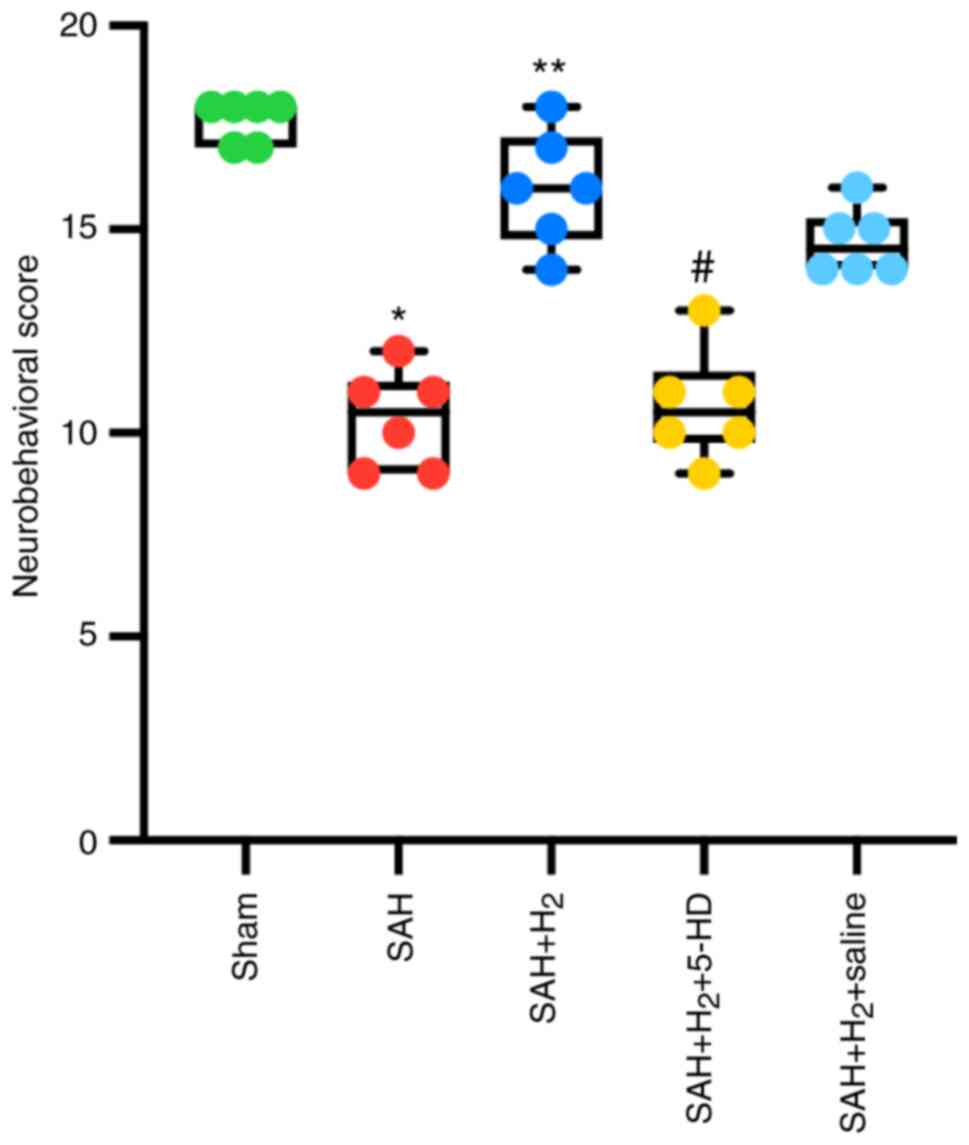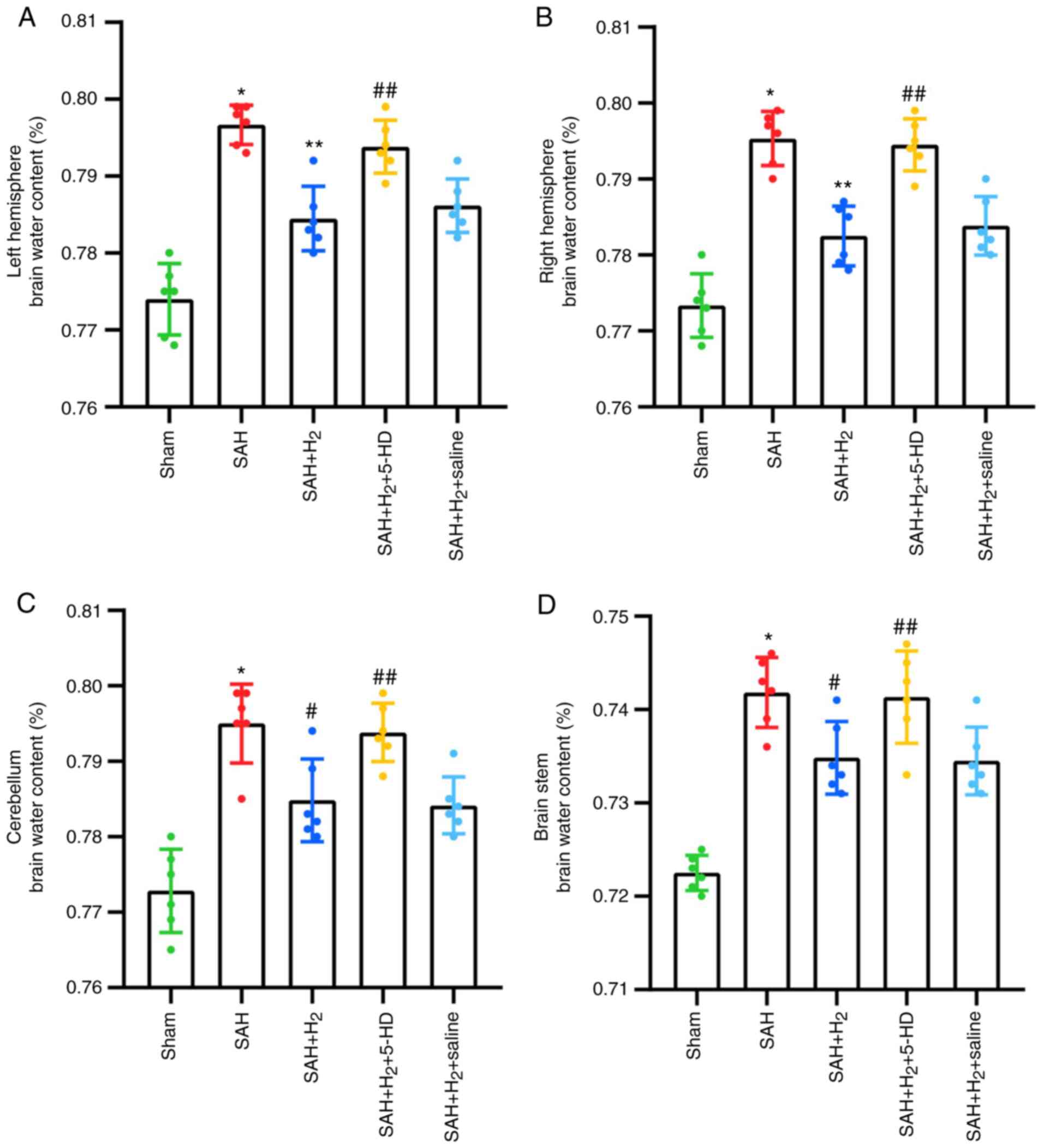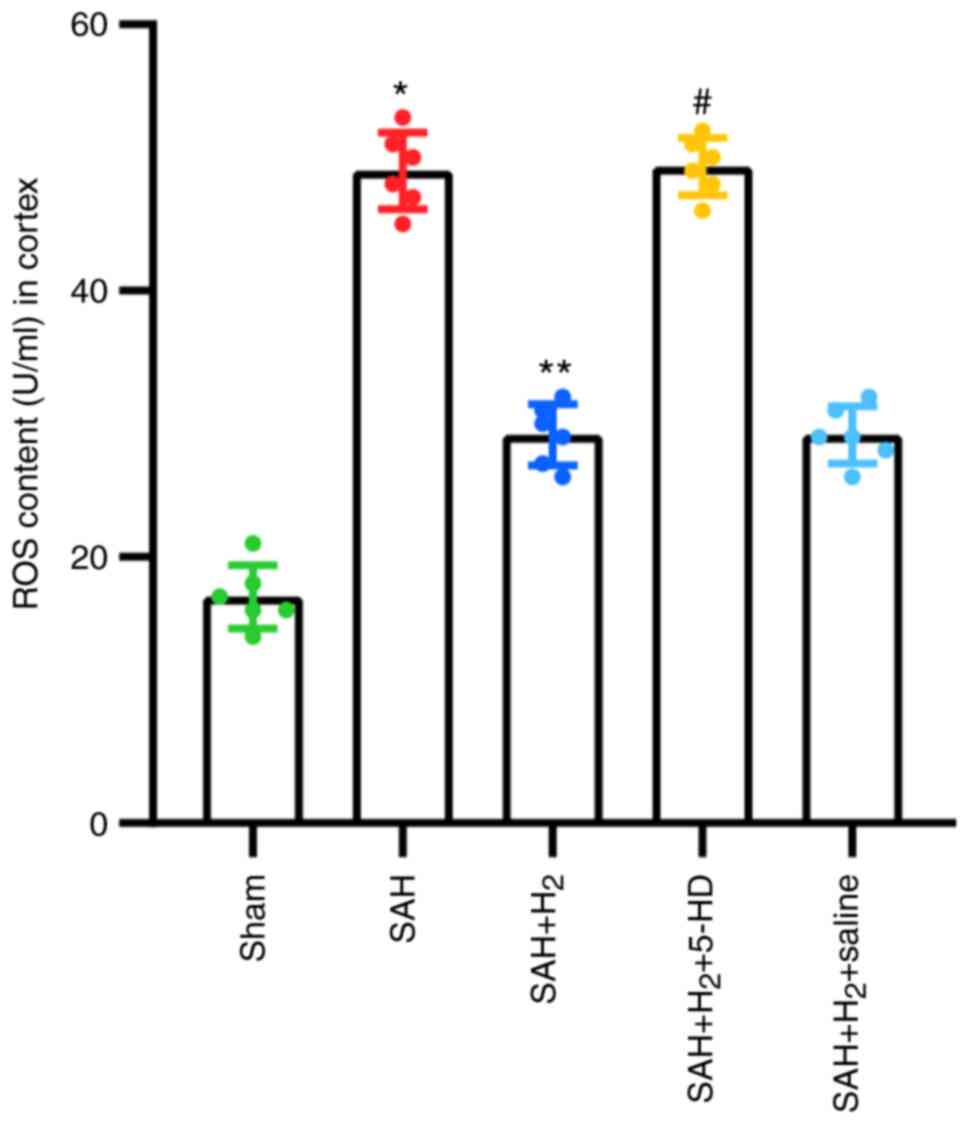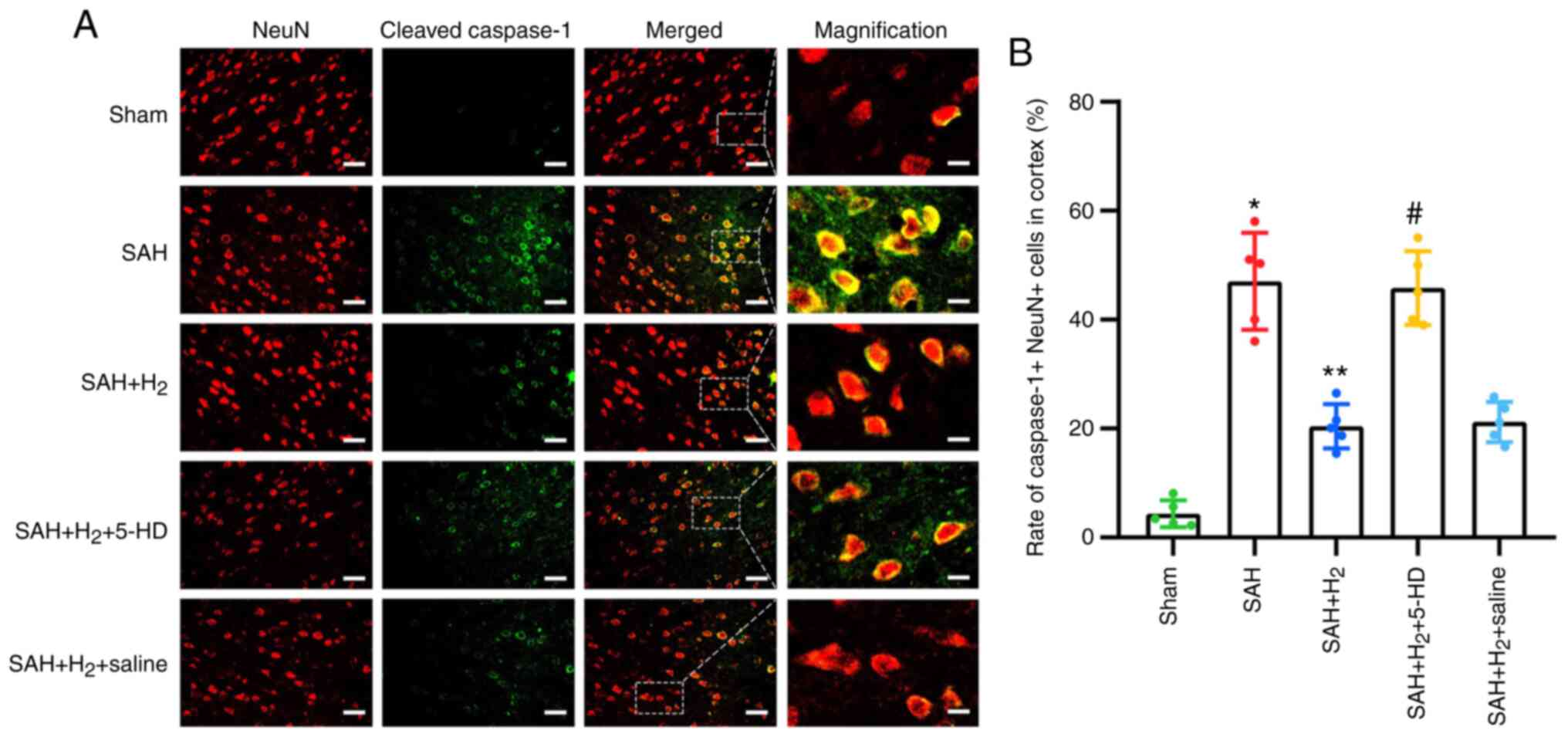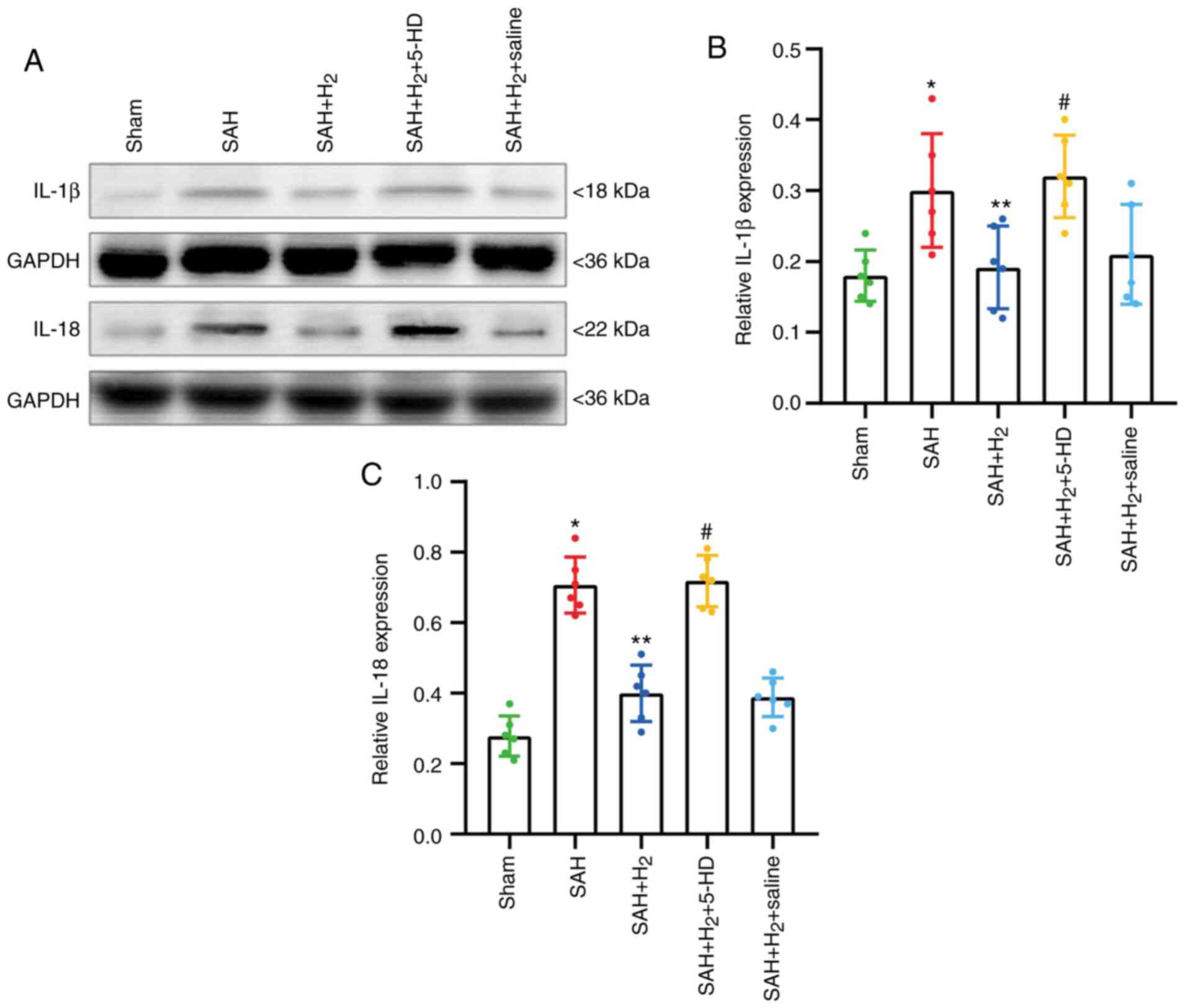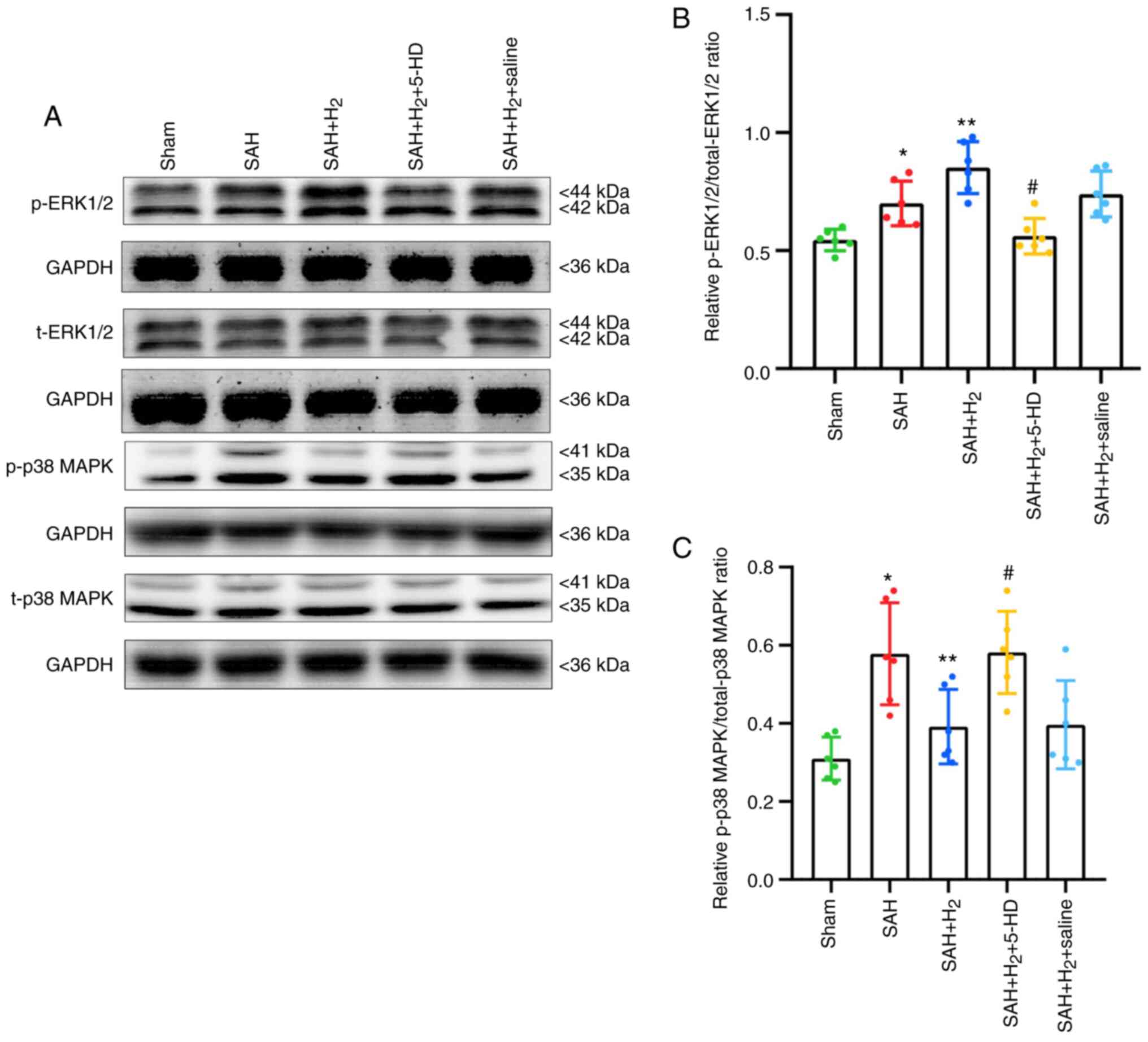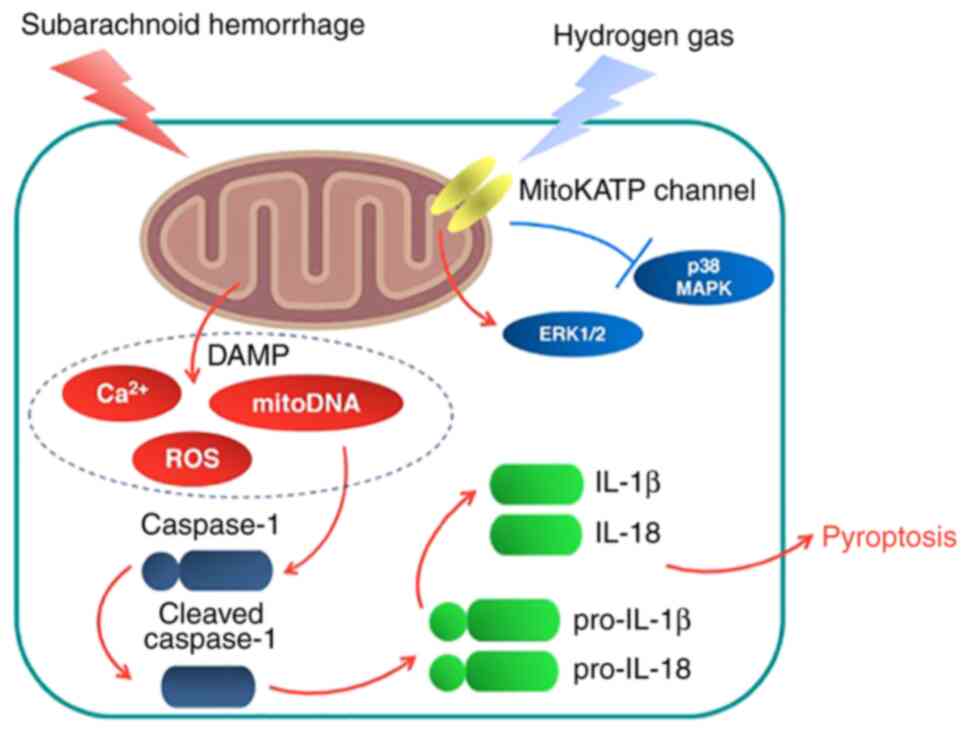|
1
|
Yang C, Li T, Xue H, Wang L, Deng L, Xie
Y, Bai X, Xin D, Yuan H, Qiu J, et al: Inhibition of necroptosis
rescues SAH-induced synaptic impairments in hippocampus via
CREB-BDNF pathway. Front Neurosci. 12(990)2019.PubMed/NCBI View Article : Google Scholar
|
|
2
|
Zhan Y, Chen C, Suzuki H, Hu Q, Zhi X and
Zhang JH: Hydrogen gas ameliorates oxidative stress in early brain
injury after subarachnoid hemorrhage in rats. Crit Care Med.
40:1291–1296. 2012.PubMed/NCBI View Article : Google Scholar
|
|
3
|
Xu P, Hong Y, Xie Y, Yuan K, Li J, Sun R,
Zhang X, Shi X, Li R, Wu J, et al: TREM-1 exacerbates
neuroinflammatory injury via NLRP3 inflammasome-mediated pyroptosis
in experimental subarachnoid hemorrhage. Transl Stroke Res: Aug 30,
2020 (Epub ahead of print).
|
|
4
|
Yuan B, Zhou XM, You ZQ, Xu WD, Fan JM,
Chen SJ, Han YL, Wu Q and Zhang X: Inhibition of AIM2 inflammasome
activation alleviates GSDMD-induced pyroptosis in early brain
injury after subarachnoid haemorrhage. Cell Death Dis.
11(76)2020.PubMed/NCBI View Article : Google Scholar
|
|
5
|
Zhou K, Enkhjargal B, Xie Z, Sun C, Wu L,
Malaguit J, Chen S, Tang J, Zhang J and Zhang JH: Dihydrolipoic
acid inhibits lysosomal rupture and NLRP3 through
lysosome-associated membrane protein-1/calcium/calmodulin-dependent
protein kinase II/TAK1 pathways after subarachnoid hemorrhage in
rat. Stroke. 49:175–183. 2018.PubMed/NCBI View Article : Google Scholar
|
|
6
|
Ruan W, Hu J, Zhou H, Li Y, Xu C, Luo Y,
Chen T, Xu B, Yan F and Chen G: Intranasal wnt-3a alleviates
neuronal apoptosis in early brain injury post subarachnoid
hemorrhage via the regulation of wnt target PPAN mediated by the
moonlighting role of aldolase C. Neurochem Int.
134(104656)2020.PubMed/NCBI View Article : Google Scholar
|
|
7
|
Shao A, Wu H, Hong Y, Tu S, Sun X, Wu Q,
Zhao Q, Zhang J and Sheng J: Hydrogen-rich saline attenuated
subarachnoid hemorrhage-induced early brain injury in rats by
suppressing inflammatory response: Possible involvement of NF-κB
pathway and NLRP3 inflammasome. Mol Neurobiol. 53:3462–3476.
2016.PubMed/NCBI View Article : Google Scholar
|
|
8
|
Ohsawa I, Ishikawa M, Takahashi K,
Watanabe M, Nishimaki K, Yamagata K, Katsura K, Katayama Y, Asoh S
and Ohta S: Hydrogen acts as a therapeutic antioxidant by
selectively reducing cytotoxic oxygen radicals. Nat Med.
13:688–694. 2007.PubMed/NCBI View
Article : Google Scholar
|
|
9
|
Xie K, Zhang Y, Wang Y, Meng X, Wang Y, Yu
Y and Chen H: Hydrogen attenuates sepsis-associated encephalopathy
by NRF2 mediated NLRP3 pathway inactivation. Inflamm Res.
69:697–710. 2020.PubMed/NCBI View Article : Google Scholar
|
|
10
|
Ono H, Nishijima Y, Ohta S, Sakamoto M,
Kinone K, Horikosi T, Tamaki M, Takeshita H, Futatuki T, Ohishi W,
et al: Hydrogen gas inhalation treatment in acute cerebral
infarction: A randomized controlled clinical study on safety and
neuroprotection. J Stroke Cerebrovasc Dis. 26:2587–2594.
2017.PubMed/NCBI View Article : Google Scholar
|
|
11
|
Zhang Y, Tan S, Xu J and Wang T: Hydrogen
therapy in cardiovascular and metabolic diseases: From bench to
bedside. Cell Physiol Biochem. 47:1–10. 2018.PubMed/NCBI View Article : Google Scholar
|
|
12
|
Uto K, Sakamoto S, Que W, Shimata K,
Hashimoto S, Sakisaka M, Narita Y, Yoshii D, Zhong L, Komohara Y,
et al: Hydrogen-rich solution attenuates cold ischemia-reperfusion
injury in rat liver transplantation. BMC Gastroenterol.
19(25)2019.PubMed/NCBI View Article : Google Scholar
|
|
13
|
Walewska A, Szewczyk A and Koprowski P:
Gas signaling molecules and mitochondrial potassium channels. Int J
Mol Sci. 19(3227)2018.PubMed/NCBI View Article : Google Scholar
|
|
14
|
Oh GS, Pae HO, Lee BS, Kim BN, Kim JM, Kim
HR, Jeon SB, Jeon WK, Chae HJ and Chung HT: Hydrogen sulfide
inhibits nitric oxide production and nuclear factor-kappaB via heme
oxygenase-1 expression in RAW264.7 macrophages stimulated with
lipopolysaccharide. Free Radic Biol Med. 41:106–119.
2006.PubMed/NCBI View Article : Google Scholar
|
|
15
|
Carreras MC and Poderoso JJ: Mitochondrial
nitric oxide in the signaling of cell integrated responses. Am J
Physiol Cell Physiol. 292:C1569–C1580. 2007.PubMed/NCBI View Article : Google Scholar
|
|
16
|
Zhai Y, Zhou X, Dai Q, Fan Y and Huang X:
Hydrogen-rich saline ameliorates lung injury associated with cecal
ligation and puncture-induced sepsis in rats. Exp Mol Pathol.
98:268–276. 2015.PubMed/NCBI View Article : Google Scholar
|
|
17
|
King AL and Lefer DJ: Cytoprotective
actions of hydrogen sulfide in ischaemia-reperfusion injury. Exp
Physiol. 96:840–846. 2011.PubMed/NCBI View Article : Google Scholar
|
|
18
|
Sugawara T, Ayer R, Jadhav V, Chen W,
Tsubokawa T and Zhang JH: Simvastatin attenuation of cerebral
vasospasm after subarachnoid hemorrhage in rats via increased
phosphorylation of Akt and endothelial nitric oxide synthase. J
Neurosci Res. 86:3635–3643. 2008.PubMed/NCBI View Article : Google Scholar
|
|
19
|
Sehba FA: The rat endovascular perforation
model of subarachnoid hemorrhage. Acta Neurochir Suppl.
120:321–324. 2015.PubMed/NCBI View Article : Google Scholar
|
|
20
|
Garcia JH, Wagner S, Liu KF and Hu XJ:
Neurological deficit and extent of neuronal necrosis attributable
to middle cerebral artery occlusion in rats. Statistical
validation. Stroke. 26:627–635. 1995.PubMed/NCBI View Article : Google Scholar
|
|
21
|
Liu W, Li R, Yin J, Guo S, Chen Y, Fan H,
Li G, Li Z, Li X, Zhang X, et al: Mesenchymal stem cells alleviate
the early brain injury of subarachnoid hemorrhage partly by
suppression of Notch1-dependent neuroinflammation: Involvement of
botch. J Neuroinflammation. 16(8)2019.PubMed/NCBI View Article : Google Scholar
|
|
22
|
Zhang DX, Zhang LM, Zhao XC and Sun W:
Neuroprotective effects of erythropoietin against
sevoflurane-induced neuronal apoptosis in primary rat cortical
neurons involving the EPOR-Erk1/2-Nrf2/Bach1 signal pathway. Biomed
Pharmacothery. 87:332–341. 2017.PubMed/NCBI View Article : Google Scholar
|
|
23
|
Zhang XX, He FF, Yan GL, Li HN, Li D, Ma
YL, Wang F, Xu N and Cao F: Neuroprotective effect of cerebralcare
granule after cerebral ischemia/reperfusion injury. Neural Regen
Res. 11:623–629. 2016.PubMed/NCBI View Article : Google Scholar
|
|
24
|
Huang S, Li H and Ge J: A cardioprotective
insight of the cystathionine γ-lyase/hydrogen sulfide pathway. Int
J Cardiol Heart Vasc. 7:51–57. 2015.PubMed/NCBI View Article : Google Scholar
|
|
25
|
Wellman GC: Ion channels and calcium
signaling in cerebral arteries following subarachnoid hemorrhage.
Neurol Res. 28:690–702. 2006.PubMed/NCBI View Article : Google Scholar
|
|
26
|
Chaudhry SR, Frede S, Seifert G, Kinfe TM,
Niemelä M, Lamprecht A and Muhammad S: Temporal profile of serum
mitochondrial DNA (mtDNA) in patients with aneurysmal subarachnoid
hemorrhage (aSAH). Mitochondrion. 47:218–226. 2019.PubMed/NCBI View Article : Google Scholar
|
|
27
|
Zhou K, Shi L, Wang Z, Zhou J, Manaenko A,
Reis C, Chen S and Zhang J: RIP1-RIP3-DRP1 pathway regulates NLRP3
inflammasome activation following subarachnoid hemorrhage. Exp
Neurol. 295:116–124. 2017.PubMed/NCBI View Article : Google Scholar
|
|
28
|
Van Opdenbosch N, Gurung P, Vande Walle L,
Fossoul A, Kanneganti TD and Lamkanfi M: Activation of the NLRP1b
inflammasome independently of ASC-mediated caspase-1
autoproteolysis and speck formation. Nat Commun.
5(3209)2014.PubMed/NCBI View Article : Google Scholar
|
|
29
|
Samir P, Kesavardhana S, Patmore DM,
Gingras S, Malireddi RKS, Karki R, Guy CS, Briard B, Place DE,
Bhattacharya A, et al: DDX3X acts as a live-or-die checkpoint in
stressed cells by regulating NLRP3 inflammasome. Nature.
573:590–594. 2019.PubMed/NCBI View Article : Google Scholar
|
|
30
|
Hoque R, Sohail M, Malik A, Sarwar S, Luo
Y, Shah A, Barrat F, Flavell R, Gorelick F, Husain S and Mehal W:
TLR9 and the NLRP3 inflammasome link acinar cell death with
inflammation in acute pancreatitis. Gastroenterology. 141:358–369.
2011.PubMed/NCBI View Article : Google Scholar
|
|
31
|
Zhang ZY, Jiang M, Fang J, Yang MF, Zhang
S, Yin YX, Li DW, Mao LL, Fu XY, Hou YJ, et al: Enhanced
therapeutic potential of nano-curcumin against subarachnoid
hemorrhage-induced blood-brain barrier disruption through
inhibition of inflammatory response and oxidative stress. Mol
Neurobiol. 54:1–14. 2017.PubMed/NCBI View Article : Google Scholar
|
|
32
|
Zhang Z, Liu J, Fan C, Mao L, Xie R, Wang
S, Yang M, Yuan H, Yang X, Sun J, et al: The GluN1/GluN2B NMDA
receptor and metabotropic glutamate receptor 1 negative allosteric
modulator has enhanced neuroprotection in a rat subarachnoid
hemorrhage model. Exp Neurol. 301:13–25. 2018.PubMed/NCBI View Article : Google Scholar
|
|
33
|
Wang W, Han P, Xie R, Yang M, Zhang C, Mi
Q, Sun B and Zhang Z: TAT-mGluR1 attenuation of neuronal apoptosis
through prevention of MGluR1α truncation after experimental
subarachnoid hemorrhage. ACS Chem Neurosci. 10:746–756.
2019.PubMed/NCBI View Article : Google Scholar
|
|
34
|
Chen J, Zhang C, Yan T, Yang L, Wang Y,
Shi Z, Li M and Chen Q: Atorvastatin ameliorates early brain injury
after subarachnoid hemorrhage via inhibition of pyroptosis and
neuroinflammation. J Cell Physiol: Mar 31, 2021 (Epub ahead of
print).
|
|
35
|
Chen L, Chao Y, Cheng P, Li N, Zheng H and
Yang Y: UPLC-QTOF/MS-based metabolomics reveals the protective
mechanism of hydrogen on mice with ischemic stroke. Neurochem Res.
44:1950–1963. 2019.PubMed/NCBI View Article : Google Scholar
|
|
36
|
Chen CH, Manaenko A, Zhan Y, Liu WW,
Ostrowki RP, Tang J and Zhang JH: Hydrogen gas reduced acute
hyperglycemia-enhanced hemorrhagic transformation in a focal
ischemia rat model. Neuroscience. 169:402–414. 2010.PubMed/NCBI View Article : Google Scholar
|
|
37
|
Buchholz BM, Kaczorowski DJ, Sugimoto R,
Yang R, Wang Y, Billiar TR, McCurry KR, Bauer AJ and Nakao A:
Hydrogen inhalation ameliorates oxidative stress in transplantation
induced intestinal graft injury. Am J Transplant. 8:2015–2024.
2008.PubMed/NCBI View Article : Google Scholar
|
|
38
|
Yao L, Chen H, Wu Q and Xie K:
Hydrogen-rich saline alleviates inflammation and apoptosis in
myocardial I/R injury via PINK-mediated autophagy. Int J Mol Med.
44:1048–1062. 2019.PubMed/NCBI View Article : Google Scholar
|
|
39
|
Ohno K and Ito M, Ichihara M and Ito M:
Molecular hydrogen as an emerging therapeutic medical gas for
neurodegenerative and other diseases. Oxid Med Cell Longev.
2012(353152)2012.PubMed/NCBI View Article : Google Scholar
|
|
40
|
Noda M, Liu J and Long J: Neuroprotective
and preventative effects of molecular hydrogen. Curr Pharm Des.
27:585–591. 2021.PubMed/NCBI View Article : Google Scholar
|
|
41
|
Watanabe M, Katsura K, Ohsawa I, Mizukoshi
G, Takahashi K, Asoh S, Ohta S and Katayama Y: Involvement of
mitoKATP channel in protective mechanisms of cerebral ischemic
tolerance. Brain Res. 1238:199–207. 2008.PubMed/NCBI View Article : Google Scholar
|
|
42
|
Garlid KD, Paucek P, Yarov-Yarovoy V,
Murray HN, Darbenzio RB, D'Alonzo AJ, Lodge NJ, Smith MA and Grover
GJ: Cardioprotective effect of diazoxide and its interaction with
mitochondrial ATP-sensitive K+ channels. Possible mechanism of
cardioprotection. Circ Res. 81:1072–1082. 1997.PubMed/NCBI View Article : Google Scholar
|
|
43
|
Jabůrek M, Yarov-Yarovoy V, Paucek P and
Garlid KD: State-dependent inhibition of the mitochondrial KATP
channel by glyburide and 5-hydroxydecanoate. J Biol Chem.
273:13578–13582. 1998.PubMed/NCBI
|
|
44
|
Naitoh K, Ichikawa Y, Miura T, Nakamura Y,
Miki T, Ikeda Y, Kobayashi H, Nishihara M, Ohori K and Shimamoto K:
MitoKATP channel activation suppresses gap junction permeability in
the ischemic myocardium by an ERK-dependent mechanism. Cardiovasc
Res. 70:374–383. 2006.PubMed/NCBI View Article : Google Scholar
|
|
45
|
Bu X, Huang P, Qi Z, Zhang N, Han S, Fang
L and Li J: Cell type-specific activation of p38 MAPK in the brain
regions of hypoxic preconditioned mice. Neurochem Int. 51:459–466.
2007.PubMed/NCBI View Article : Google Scholar
|
|
46
|
Li J, Lang MJ, Mao XB, Tian L and Feng YB:
Antiapoptosis and mitochondrial effect of pioglitazone
preconditioning in the ischemic/reperfused heart of rat. Cardiovasc
Drugs Ther. 22:283–291. 2008.PubMed/NCBI View Article : Google Scholar
|
|
47
|
Chen S, Zuo Y, Huang L, Sherchan P, Zhang
J, Yu Z, Peng J, Zhang J, Zhao L, Doycheva D, et al: The
MC4 receptor agonist RO27-3225 inhibits NLRP1-dependent
neuronal pyroptosis via the ASK1/JNK/p38 MAPK pathway in a mouse
model of intracerebral haemorrhage. Br J Pharmacol. 176:1341–1356.
2019.PubMed/NCBI View Article : Google Scholar
|
|
48
|
Subramaniam S, Strelau J and Unsicker K:
GDNF prevents TGF-beta-induced damage of the plasma membrane in
cerebellar granule neurons by suppressing activation of p38-MAPK
via the phosphatidylinositol 3-kinase pathway. Cell Tissue Res.
331:373–383. 2008.PubMed/NCBI View Article : Google Scholar
|
|
49
|
Kello M, Kulikova L, Vaskova J, Nagyova A
and Mojzis J: Fruit peel polyphenolic extract-induced apoptosis in
human breast cancer cells is associated with ROS production and
modulation of p38MAPK/Erk1/2 and the akt signaling pathway. Nutr
Cancer. 69:920–931. 2017.PubMed/NCBI View Article : Google Scholar
|
|
50
|
Pan H, Yu M, Chen M, Wang X, Zhang H, Du S
and Yu S: miR-126 suppresses neuronal apoptosis in rats after
cardiopulmonary resuscitation via regulating p38MAPK. Hum Exp
Toxicol. 39:563–574. 2020.PubMed/NCBI View Article : Google Scholar
|
|
51
|
Matei N, Camara R and Zhang JH: Emerging
mechanisms and novel applications of hydrogen gas therapy. Med Gas
Res. 8:98–102. 2018.PubMed/NCBI View Article : Google Scholar
|















